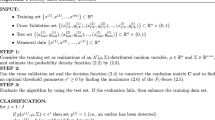Abstract
Terahertz tomography represents an emerging field in the area of nondestructive testing. Detecting outliers in measurements that are caused by defects is the main challenge in inline process monitoring. An efficient inline control enables to intervene directly during the manufacturing process and, consequently, to reduce product discard. We focus on plastics and ceramics and propose a density-based technique to automatically detect anomalies in the measured data of the radiation. The algorithm relies on a classification method based on machine learning. For a verification, supervised data are generated by a measuring system that approximates an inline process. The experimental results show that the use of terahertz radiation, combined with the classification algorithm, has great potential for a real inline manufacturing process.
Supported by the German Plastics Center (SKZ) and partially funded by German Federation of Industrial Research Associations (AiF) under 19948 N.
Access this chapter
Tax calculation will be finalised at checkout
Purchases are for personal use only
Similar content being viewed by others
References
Chandola, V., Banerjee, A., Kumar, V.: Anomaly detection: a survey. ACM Comput. Surv. (CSUR) 41(3), 1–58 (2009)
Davis, J., Goadrich, M.: The relationship between precision-recall and ROC curves. In: Proceedings of the 23rd International Conference on Machine Learning, pp. 233–240 (2006)
Dhillon, S., et al.: The 2017 terahertz science and technology roadmap. J. Phys. D Appl. Phys. 50(4), 043001 (2017)
Eden, K., Gebhard, H.: Dokumentation in der Mess-und Prüftechnik. Springer, Wiesbaden (2014). https://doi.org/10.1007/978-3-658-06114-2
Ferguson, B., Zhang, X.C.: Materials for terahertz science and technology. Nat. Mater. 1(1), 26–33 (2002)
Guillet, J.P., et al.: Review of terahertz tomography techniques. J. Infrared Millim. Terahertz Waves 35(4), 382–411 (2014)
Krumbholz, N., et al.: Monitoring polymeric compounding processes inline with THz time-domain spectroscopy. Polym. Test. 28(1), 30–35 (2009)
Limthong, K.: Real-time computer network anomaly detection using machine learning techniques. J. Adv. Comput. Netw. 1(1), 126–133 (2013)
Mehrotra, K., Mohan, C., Huang, H.: Anomaly Detection Principles and Algorithms. Springer, Cham (2017). https://doi.org/10.1007/978-3-319-67526-8
Nüßler, D., Jonuscheit, J.: Terahertz based non-destructive testing (NDT): making the invisible visible. tm-Technisches Messen 1(ahead-of-print) (2020)
Tepe, J., Schuster, T., Littau, B.: A modified algebraic reconstruction technique taking refraction into account with an application in terahertz tomography. Inverse Probl. Sci. Eng. 25(10), 1448–1473 (2017)
Tharwat, A.: Classification assessment methods. Appl. Comput. Inform. 17(6), 168–192 (2020)
Tzydynzhapov, G., Gusikhin, P., Muravev, V., Dremin, A., Nefyodov, Y., Kukushkin, I.: New real-time sub-terahertz security body scanner. J. Infrared Millim. Terahertz Waves 41, 1–10 (2020)
Wald, A., Schuster, T.: Terahertz tomographic imaging using sequential subspace optimization. In: Hofmann, B., Leitao, A., Zubelli, J.P. (eds.) New Trends in Parameter Identification for Mathematical Models. Trends in Mathematics, Birkhäuser Basel (2018)
Zhong, S.: Progress in terahertz nondestructive testing: a review. Front. Mech. Eng. 14(3), 273–281 (2018). https://doi.org/10.1007/s11465-018-0495-9
Zouaghi, W., Thomson, M., Rabia, K., Hahn, R., Blank, V., Roskos, H.: Broadband terahertz spectroscopy: principles, fundamental research and potential for industrial applications. Eur. J. Phys. 34(6), 179–199 (2013)
Author information
Authors and Affiliations
Corresponding author
Editor information
Editors and Affiliations
Rights and permissions
Copyright information
© 2022 Springer Nature Switzerland AG
About this paper
Cite this paper
Meiser, C., Schuster, T., Wald, A. (2022). A Classification Algorithm for Anomaly Detection in Terahertz Tomography. In: Lirkov, I., Margenov, S. (eds) Large-Scale Scientific Computing. LSSC 2021. Lecture Notes in Computer Science, vol 13127. Springer, Cham. https://doi.org/10.1007/978-3-030-97549-4_45
Download citation
DOI: https://doi.org/10.1007/978-3-030-97549-4_45
Published:
Publisher Name: Springer, Cham
Print ISBN: 978-3-030-97548-7
Online ISBN: 978-3-030-97549-4
eBook Packages: Computer ScienceComputer Science (R0)




